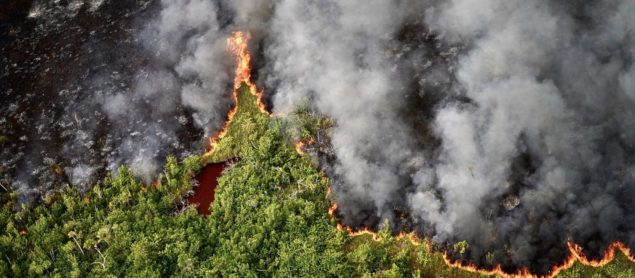|
Getting your Trinity Audio player ready...
|

As wildfires cause increasing devastation worldwide, dozens of fire experts across the nation are joining together in calling for a more strategic and interdisciplinary approach to pursuing wildfire research and protecting vulnerable communities.
A new study — published in the Proceedings of the National Academy of Sciences (PNAS) Nexus journal — co-authored by FIU Institute of Environment ecologist John Kominoski and 86 other fire experts from a breadth of disciplines, highlights the obstacles for fire science and provides guidance for investing in future research.
The researchers led by Jacquelyn Shuman, a scientist at the National Center for Atmospheric Research (NCAR), are making their recommendations at a time when wildfires pose an increasing global risk spurred largely by climate change, generations of fire suppression and more development that encroaches on wildlands.
Recent decades have seen a substantial increase in the length of fire season as far north as the Arctic, as well as intense conflagrations from the Pantanal tropical wetland in South America to the peatlands of tropical Asia. In the western United States, warmer and drier conditions have spurred fires that have burned nearly twice the area in the 21st century compared with the late 20th century.
But the Florida Everglades tell a different story. Although wildfires exist in the Everglades, the area of wetlands burned by wildfires has drastically reduced in recent decades. This phenomenon is largely attributed to restoration and better water management that both keep Everglades wetlands wet. Instead, they rely on prescribed burns to clear out vegetation and release nutrients that spur regrowth in the rainy season, according to Kominoski, who leads the NSF-funded Florida Coastal Everglades Long Term Research program at FIU.
“Even though wildfire is natural, the way we historically managed water in the Everglades was not,” Kominoski said. “When we look at the fire history of the Everglades, we see that where fires have occurred are correlated with where wetlands have had less water. Now that Everglades restoration is rehydrating wetlands, the area burned through prescribed fire has gone up dramatically, exponentially.”
In a subsequent study on Everglades wildfires, Kominoski and his collaborators from Archbold Biological Station near Lake Okeechobee, discovered that drier areas burned better, released more phosphorus and in turn created a more conducive environment for regrowth when water was reintroduced to the area.
The national wildfire commentary is a follow-up to a five-day innovation lab, sponsored by the U.S. National Science Foundation (NSF), that brought together diverse research communities in May 2021 to develop a roadmap for new research directions.
Recognizing the need for a more convergent approach, the innovation lab last year brought together experts at federal agencies and universities. They represented fields ranging from ecology, forestry and anthropology to geomorphology, hydrology, and computer science, among others.
The study outlines five key challenges to advance the study of fire. These range from promoting coordinated research to drawing on diverse sources of knowledge.
The five challenges outlined in the paper, which built on those discussions, are:
- Integrate among disciplines by promoting coordination among physical, biological, and social sciences. Fire research currently is siloed within disciplines such as forestry, atmospheric chemistry, and others, but wildfire is a biophysical and social phenomenon that cannot be understood with any single disciplinary lens.
- Embrace different ways of knowing and knowledge generation to identify resilience pathways. Humans from diverse groups and perspectives, including indigenous peoples of tribal nations, can provide scientists with invaluable insights into fire.
- Use fire as a lens to address fundamental science questions. Fire is such an ancient and pervasive phenomenon that it can be used to help gain new insights into a range of sciences, including ecology and evolutionary biology, the evolution of Homo sapiens, and social dynamics.
- Capitalize on the “firehose” of data to support community values. With more data now available to study fire in the biosphere than ever before, scientists need funding to harness the data revolution and aid our understanding of fire.
- Develop coupled models that include human dimensions to better anticipate future fire. To better anticipate future fire activity and its impacts, scientists need to develop more advanced computer modeling systems that incorporate both the human and non-human dimensions of fire.
“We have far more information about fires than before, but we need increased funding and better coordination to deploy it on a global scale,” said NCAR’s Shuman, the study’s lead author. “This will enable us to be more proactive as we work to help society and ecosystems become more resilient to the increasing risk of fires.”





